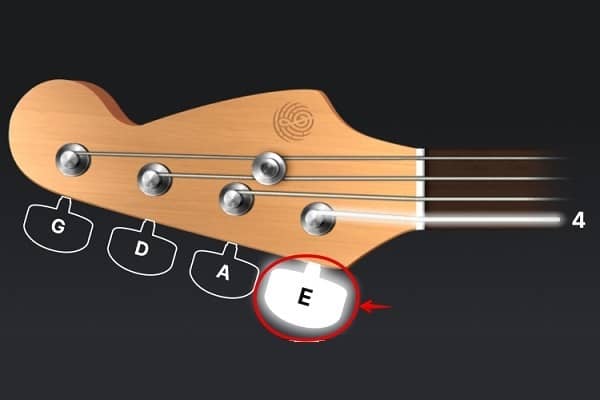If you’ve just started your journey with the bass guitar, one of the first things you’ll need to learn is how to tune it. Getting your bass in tune is crucial for making it sound its best and ensuring it blends well when you play with other instruments.
Don’t worry though, tuning your bass is easier than you think! In this comprehensive guide, we’ll walk you through the ins and outs of bass guitar tuning so you can get jamming in no time.
We’ll start by going over the basic anatomy of a bass and the fundamentals of how the strings produce different notes. Then we’ll cover the various methods you can use to tune up accurately.
We’ll also provide some handy tuning tips for keeping your bass in tune once it’s properly set up. By the end, you’ll have all the knowledge you need to tune your bass quickly and confidently before each practice or performance session. Let’s dive in!
Anatomy of a Bass Guitar
Before we get into the specifics of tuning, it helps to understand the basic components that allow a bass guitar to produce different pitches. The main parts that affect tuning are the headstock, tuning machines, and strings.
Located at the end of the bass’s neck, the headstock houses the tuning machines for each string. These tuning machines consist of tuning keys or pegs that you turn to tighten or loosen a string, changing its tension and pitch.
Most standard 4-string bass guitars are tuned to E, A, D, G from the lowest to highest string. The thick strings vibrate at lower frequencies to produce deep bass tones.
Some bassists prefer the extended range of 5 or 6-string basses. A 5-string adds a lower B string, while a 6-string also adds a high C string.
The principles of tuning remain the same no matter the number of strings. The key is learning to recognize when a string is in tune and making adjustments as needed.
Why Tuning Matters

You may be wondering why it’s so important to tune your bass. Here are some of the key reasons:
- Sounds better with other instruments – When your bass is out of tune, it will clash with other instruments and voices. Proper tuning allows everything to blend harmoniously.
- Easier to play melodies and chords – Playing fretted notes and chords in tune is much easier when your strings are tuned accurately.
- Consistent tone and pitch – Your bass will have a focused, centered sound when tuned properly. The notes will resonate with more clarity and character.
Simply put, an out-of-tune bass can negatively impact your sound, technique, and musicality. Just a few minutes of tuning before playing or practicing can make a huge difference.
When to Tune Your Bass
Here are some common times you’ll want to tune your bass guitar:
- Before each practice or gig – It’s a good habit to check tuning every time you play. Temperature changes and string wear affect tuning over time.
- If it sounds off while playing – If notes seem unclear or you’re having trouble locking in with the band, your bass may be out of tune.
- Seasonal climate changes – As humidity increases or decreases with the seasons, your strings will go out of tune more frequently.
- New strings need extra tuning – After changing your bass strings, allow them to stretch and stabilize by re-tuning periodically.
Err on the side of caution and tune your bass whenever something doesn’t seem right with your sound. At most performances, take a quick tuning break between sets or songs to get back in tune.
How to Tune a Bass Guitar (With/Without Tuner)
Now let’s get into the various methods you can use to accurately tune your bass guitar. There are three main approaches:
Using Electronic Tuners
Electronic tuners are the quickest and easiest way to tune up. These devices detect the frequency of your strings electronically and tell you whether each note is sharp (too high), flat (too low), or in tune.
There are several types of electronic tuners available:
- Clip-on tuners – These attach directly to your bass’s headstock to sense string vibrations. Simple to use and very precise.
- Pedal tuners – Tuner pedals are handy to keep in your effects chain for on-the-fly tuning on stage.
- Tuning apps – A plethora of free and inexpensive tuner apps offer tuning capabilities right on your smartphone.
To use an electronic tuner, play each open string one by one while watching the display. Turn the corresponding tuning key to adjust the string until the tuner shows it’s in tune. Easy as that!
Tuning to a Reference Pitch
If you don’t have access to an electronic tuner, you can tune your bass to a reference pitch instead. Here are some sources of reference pitches you can use:
- Piano or guitar – Match the pitch of your strings to tuned notes played on these instruments.
- Tuning forks – When struck, these resonate at a specific pitch like A440.
- Tuning metronomes – These produce reference pitches such as A or C in addition to a steady beat.
Start by matching your lowest E string to the reference. Play the pitch on your reference instrument, then play the E string and turn the tuning key until they match.
Tune the other strings in the same way, working from low to high. This method takes a good ear, but gets easier with practice.
Interval Tuning
In some cases, such as jam sessions without a tuner available, you can tune your bass using the interval tuning method. This involves tuning strings relative to each other rather than to reference pitches. Here’s how it works:
- Play the 5th fret harmonic on the E string, then play the open A string. Adjust the A string until the pitches match.
- Next, play the 5th fret harmonic on the A string. Tune the open D string until it matches.
- Finally, play the 5th fret harmonic on the D string and match the open G string to it.
Interval tuning won’t get you perfectly in tune, but enables quick relative tuning when needed. Use harmonics rather than fretted notes for the most accurate results.
Tuning Your Bass Guitar 4 String
Now that you know some tuning methods, let’s look at how to properly tune each individual string on a 4-string bass guitar:

Low E String
As the lowest string, the pitch of the open E string is your starting point. Tune this first to your reference note E using an electronic tuner or by matching a piano, guitar, etc. Turn the low E-tuning machine head to adjust.
A String
After the E, tune your open A string. Play your reference A pitch and turn the A string’s tuning key until the tones match. Getting these first two strings tuned correctly makes the rest easier.
D String
Moving up, tune your open D string next. Play a D reference pitch and adjust the D string tighter or looser until it’s in tune. Make sure to tune just the D string without affecting E and A.
G String
Finally, tune the open G string to match your G reference pitch. Congrats, you’ve now tuned all four strings on your bass! Double check each string and make minor adjustments until everything is in tune.
Alternate Bass Tunings
While standard EADG tuning is most common, you can explore different sounds with alternate bass tunings:
- Drop D – Lowering the E string to D extends the lower range and adds a bluesy flair.
- Drop C – Heavier styles use Drop C tuning by lowering the E to C for seriously deep tones.
- Open tunings – Strings are tuned to form a chord, like all fifths for a powerful open sound.
- Drop tuners – Pedals like the DigiTech Drop allow quick switching between standard and drop tunings.
Experiment with alternate tunings to find new tonal possibilities and inspiration! The tuning principles remain the same.
Ready to see these bass guitar tuning techniques in action? Watch this beginner-friendly video guide for hands-on tips and a visual demonstration!

Tuning Tips for Better Intonation
Tuning your bass before playing is only half the battle – keeping it in tune is just as important. Here are some tips to improve tuning stability and intonation:
- Adjust intonation – Fine-tune string length at the bridge so notes across the neck are in tune.
- Check tuning at higher frets – An open string may be in tune while fretted notes sound off.
- Set up proper string height – Higher action causes intonation problems. Set string height for easy fretting and clear tones.
- Use newer strings – Old strings that have lost tension and elasticity will go out of tune faster.
Take the time to properly set up your bass for optimized intonation and handling. Combining quality strings with a great instrument setup will keep you sounding your best.
Caring for Your Strings
Your strings are one of the most important factors for staying in tune. Follow these string care tips:
- Change strings regularly – Replace old strings every few months, or more often if they lack brightness or feel stiff.
- Keep bass clean – Wipe down strings after playing to remove dirt, skin oils, and sweat that can deaden tone.
- Proper storage – Avoid exposing your bass to rapid temperature and humidity changes which can affect tuning stability.
- Use string lubricants – Applying lubricant or boiling your strings helps remove grime and revitalize tone.
With proper upkeep and regular string changes, you’ll reduce tuning frustration and keep your bass singing. Think of caring for your strings as essential maintenance for optimal performance.
Final Words
Well, there you have it, a complete guide to demystifying how to tune a bass guitar properly. The key points to remember are:
- Tune before each practice and performance session for best sound.
- Invest in an electronic tuner for fast, accurate tuning.
- Learn to recognize when your bass is going out of tune while playing.
- Try different tuning methods like harmonics for quick relative tuning.
- Care for your bass strings to improve tuning stability.
Put these bass tuning tips into action to take your playing to the next level. Most importantly, don’t be afraid to experiment and find the tuning techniques that work best for you.
Tuning your instrument is a foundational skill for every bassist. With regular practice, you’ll be tuning and jamming like a pro in no time. Now grab your bass and let’s get rockin’!
About the Author
Team Guitar Top Review Talk about Guitars! We are a group of friends that bonded over their shared love of playing guitar. We all have different backgrounds and experiences with music, but we share a passion for writing about the things that we love.



